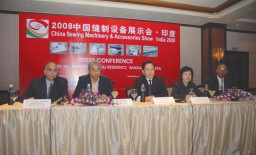
China may be a competitor in the global apparel market but, as far as technology is concerned, it is fast emerging as a major supplier of garment manufacturing machines with Indian exporters taking to Chinese machines for the ‘value for money’ advantages. An extensive range of made-in-China machines was on display recently at Bangalore, as CISMA held its first show in the country in association with CMAI as ‘CSMAS India 2008’.
The fair was small and the response lukewarm, as the displays were centered on sewing/embroidery machines, with little to show in automation and IT solutions, limiting interest of visitors. Apparel Online talked to the exhibitors and visitors on the growing acceptance of Chinese technology in India.
It cannot be denied that, with the apparel export industry slowing down in the last two years, there has been hardly any major investment in the sector as before embarking on any expansion plans most players are waiting for the industry to settle down to the new dimensions of global trade which include a stronger rupee, declining margins, sharper prices and shorter lead times. In this scenario, the importance of relatively cheaper ‘made in China’ machines cannot be overlooked.
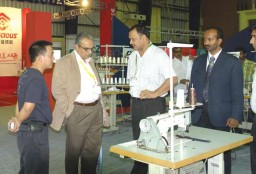
“And why not?” questions Helen Hu from Guiei Sewq, “Our machines are almost half the price of comparable technology from the west and Japan, particularly sewing machines,” she says. Her confidence is not misplaced, says an honest Jagadish Hinduja, MD, Gokaldas Images, “We do not expect innovation from the Chinese machines but good pricing.”
However, things are changing and there is a positive movement towards quality. Echoing the views of most manufacturers who exhibited their products, Mayu Chen of Dahao, argues, “Earlier Chinese manufacturers were only concerned with how much they could sell but now most of them are making concerted efforts to upgrade and create brand value for sustained growth.” Dahao was the only company displaying computerized control systems for sewing equipment.
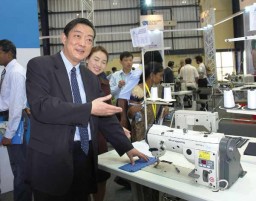
That these efforts to improve quality are now bearing fruit is evident from the sales of already present Chinese machine manufacturers in India like FDM that has in the last four years of its presence in the country sold more than 9000 machines to leading players like Gokaldas Exports, Bombay Rayon Fashions, The Shirt Company, Scott Garments to name a few.
“FDM is focusing on providing machines that can effectively address needs of the industry from quality stitching to productivity for which there is greater emphasis on R&D,” says Yogesh B, Country Manager, FDM. The brand is working in India through Mahaveer Industrial Supplier. Similarly, Typical Machines have in the last three years created a loyal following. Says Michael Chang from Typical, “Initially there were many question marks on our quality but now people know they can rely on our products for international standard sewing output.”
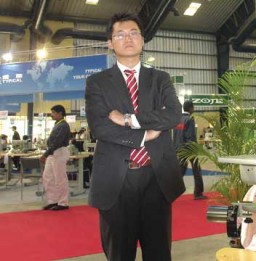
An interesting factor that has contributed to the improving quality of Chinese offerings is the growing number of new manufacturing companies that have emerged on the scene since the late 1990s. “There were very few brands in China earlier and most of the manufacturers were supplying only to these established brands but in recent times many manufacturers have started independent operations under new brand names, which has increased the competition among Chinese manufacturers and has stressed upon them the need to have distinct brand value by upgrading technology and offerings more than just basic machines,” says Ma Minliang, GM SGSB Group, manufacturers of the Shanggong brand of sewing machines.
Under the strategy to improve its image, the company acquired the German Automation leader Duerkopp Adler in 2006 giving itself a product basket that includes economical Chinese made basic machines to German made automated solutions for specialized operations.
Manufacturers are upgrading their facilities by replacing old sewing machines with newer versions but again the idea is not modernization for modernization sake but to improve productivity
Among the technology on display at Bangalore, the direct drive sewing machines dominated the exhibition with virtually every manufacturer offering a direct drive version of earlier machines. This trend is attributed to the fact that there are two areas of investment in machines today – one is productivity enhancement and the second is improving performance of basic sewing machines. And players are upgrading their facilities by replacing old sewing machines with newer versions but again the idea is not modernization for modernization sake but to improve productivity.
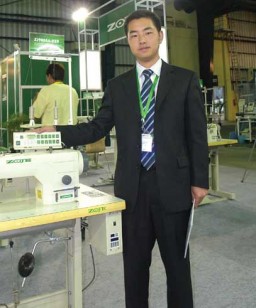
Among the direct drive options that caught attention at the fair were the ‘Needle Feed lockstitch machine’ from Typical; the oil free computerized high speed lock stitch from Hikari; the micro lubricated computer controlled high-speed lockstitch from Feiyue and the high speed needle bar oil free auto-trimmer lock stitch machine from Zoje. Also catching the eye of visitors were new high sensitive needle detectors of United Machines with the Easement brand and the WGM distributed Kaigu brand, both of which had on display dedicators with sensitivity of 0.8mm.
Other interesting displays included quilting cum embroidery machines from Richpiece, high speed computer controlled pattern sewing machines from Zoje and a new series of pressing equipment from Weishi. Companies supplying spares and motors were also a big attraction. In the maze of similar featured machines, companies vied to acquire the edge with added features and innovative sales strategies.
The competition is tough and the industry is asking for, more than good prices, innovative options that secure investment,” says Yang Yuanzeng, Director Feiyue.
Buy back option is one such advantage that the industry is looking at and on the first day of the fair itself Dinesh Hinduja, ED Gokaldas Exports showed interest in some machines saying that he would not mind buying but he would like to negotiate on who could give a decent buy back guarantee within 5 years.
There was a buzz at the event that, with the announcement of 10% subsidy on capital investment under TUF scheme, many exporters may now make fresh investments to avail the advantage of the scheme that is operational from 1st November, 2007. This news added wings to the technology providers who almost unanimously felt that India presented huge growth opportunity to the Chinese machine manufacturers as the potential for expansion in the domestic market is already well documented and there is every indication that exports should be back on track by early 2009.
“The industry is going through a rough patch but as the rupee situation settles down and prices in China continue to rise, we are hopeful that business will increase in the country and bring smiles back to the faces of exporters by the year end,” predicted Premal Udani, MD Kaytee Enterprises.






